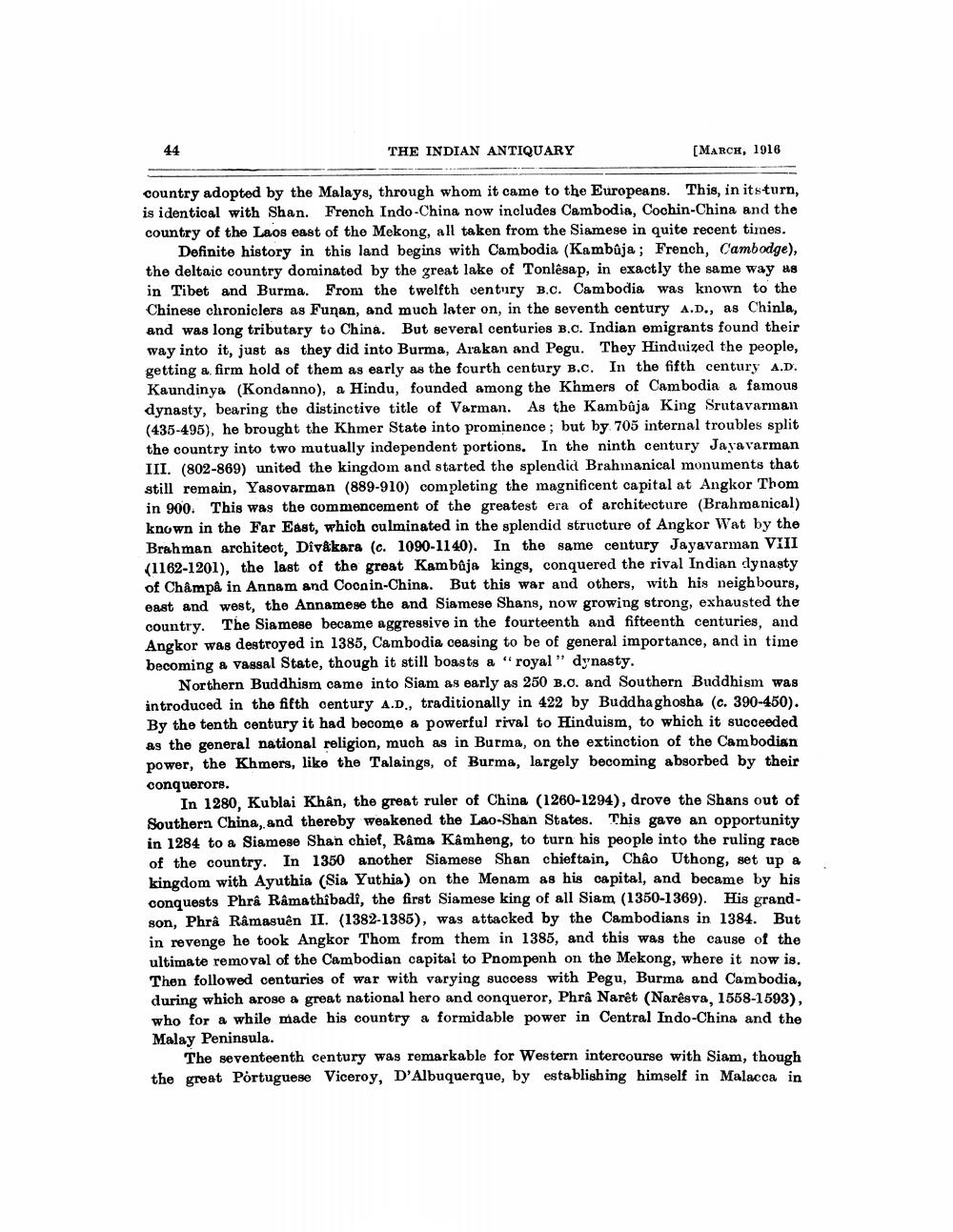________________
44
THE INDIAN ANTIQUARY
[MARCH, 1916
country adopted by the Malays, through whom it came to the Europeans. This, in itsturn, is identical with Shan. French Indo-China now includes Cambodia, Cochin-China and the country of the Laos east of the Mekong, all taken from the Siamese in quite recent times.
Definite history in this land begins with Cambodia (Kambaja; French, Cambodge), the deltaic country dominated by the great lake of Tonlesap, in exactly the same way as in Tibet and Burma. From the twelfth century B.C. Cambodia was known to the Chinese chroniclers as Funan, and much later on, in the seventh century A.D., as Chinla, and was long tributary to China. But several centuries B.C. Indian emigrants found their way into it, just as they did into Burma, Arakan and Pegu. They Hinduized the people, getting a firm hold of them as early as the fourth century B.C. In the fifth century A.D. Kaundinya (Kondanno), a Hindu, founded among the Khmers of Cambodia a famous dynasty, bearing the distinctive title of Varman. As the Kambja King Srutavarman (435-495), he brought the Khmer State into prominence; but by 705 internal troubles split the country into two mutually independent portions. In the ninth century Jayavarman III. (802-869) united the kingdom and started the splendid Brahmanical monuments that still remain, Yasovarman (889-910) completing the magnificent capital at Angkor Thom in 900. This was the commencement of the greatest era of architecture (Brahmanical) known in the Far East, which culminated in the splendid structure of Angkor Wat by the Brahman architect, Divakara (c. 1090-1140). In the same century Jayavarman VIII (1162-1201), the last of the great Kambaja kings, conquered the rival Indian dynasty of Châmpâ in Annam and Cocain-China. But this war and others, with his neighbours, east and west, the Annamese the and Siamese Shans, now growing strong, exhausted the country. The Siamese became aggressive in the fourteenth and fifteenth centuries, and Angkor was destroyed in 1385, Cambodia ceasing to be of general importance, and in time becoming a vassal State, though it still boasts a "royal" dynasty.
Northern Buddhism came into Siam as early as 250 B.C. and Southern Buddhism was introduced in the fifth century A.D., traditionally in 422 by Buddha ghosha (c. 390-450). By the tenth century it had become a powerful rival to Hinduism, to which it succeeded as the general national religion, much as in Burma, on the extinction of the Cambodian power, the Khmers, like the Talaings, of Burma, largely becoming absorbed by their conquerors.
In 1280, Kublai Khân, the great ruler of China (1260-1294), drove the Shans out of Southern China, and thereby weakened the Lao-Shan States. This gave an opportunity in 1284 to a Siamese Shan chief, Rama Kâmheng, to turn his people into the ruling race of the country. In 1350 another Siamese Shan chieftain, Chio Uthong, set up a kingdom with Ayuthia (Sia Yuthia) on the Menam as his capital, and became by his conquests Phra Ramathibadi, the first Siamese king of all Siam (1350-1369). His grandson, Phrâ Râmasuên II. (1382-1385), was attacked by the Cambodians in 1384. But in revenge he took Angkor Thom from them in 1385, and this was the cause of the ultimate removal of the Cambodian capital to Pnompenh on the Mekong, where it now is. Then followed centuries of war with varying success with Pegu, Burma and Cambodia, during which arose a great national hero and conqueror, Phra Narêt (Narêsva, 1558-1593), who for a while made his country a formidable power in Central Indo-China and the Malay Peninsula.
The seventeenth century was remarkable for Western intercourse with Siam, though the great Portuguese Viceroy, D'Albuquerque, by establishing himself in Malacca in




